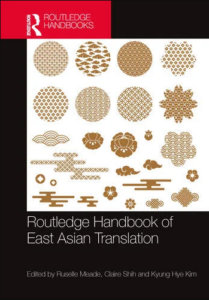
Sophie Ling-chia Wei
In Routledge Handbook of East Asian Translation (Ruselle Meade, Claire Shih, Kyung Hye Kim, eds.)
London & New York: Routledge, 2025
About the chapter: In the late Ming and early Qing dynasties, there was an influx of Catholic missionaries, especially the Jesuits, coming to China for proselytization. These Jesuits crossed linguistic and cultural borders and employed translations to disseminate Western scientific knowledge as well as the axioms of Christianity to Chinese readers. Translations as contact zones were showcased in the rewritings and re-creations of the Shan hai jing 山海經 (The Classic of Mountains and Seas) in the Jesuits’ translations. The Jesuit translators accommodated Western biblical history and scientific knowledge to Chinese classics, as a result creating a hybrid religious geography. A close-up examination of the passages selected by early Jesuits like Matteo Ricci and later Figurists from the Shan hai jing for their translations and reinterpretations reveals Ricci’s inclination to align with the interests of Chinese readers and the Figurists’ priority on Chinese history and myths; Gabriel de Magalhāes’ Shan hai jing translation, an outlier in this context, harbored negative views on Chinese culture. The translations of the Shan hai jing acted as nonbinary contact zones, neither strictly East nor West, in which the dynamic and ongoing exchanges, or push and pull, of mythical elements in the East and West were carried out by the Jesuits’ deliberate choices and manipulation and thus built a shared imagined community. Through the Jesuits’ translations and their dissemination in Europe to quench the thirst of European readers’ desire to know more about Chinese mythology and geography, the Shan hai jing was given many new purposes, many new lives.
Keywords: Shan hai jing, Jesuits, Figurists, translation, geography, typological exegesis, contact zones
About the book: This handbook draws attention to the diversity of scholarship on translation in East Asia, and its relevance to a variety of established and emerging fields. It focuses on hitherto less-explored interactions, such as intra-Asian translation encounters, translation of minority languages, and translation between East Asian and non-European languages, while also contributing to a thriving body of historical scholarship on East Asian translation traditions. Contributions reflect a growing awareness of the cultural and linguistic heterogeneity within nations, and the reality of multilingualism and plurilingualism among many communities in East Asia. A wide variety of translatorial practices are discussed, including the creative use of Chinese in Japanese-language novels, the use of translation to evade censorship online, community theatre translation, and translation of picture books. The volume also includes contributions by practitioners, who reflect on their experiences of translation and of developing training programmes for community interpreters.
This handbook will appeal to researchers and students of translation and interpreting studies. Chapters are likely to be of value to those working, not only in East Asian studies, but also disciplines such as literary studies, global cultural studies, and LGBT+ studies.
About the author: Sophie Ling-chia Wei was a HYI Visiting Scholar from 2023-24.
